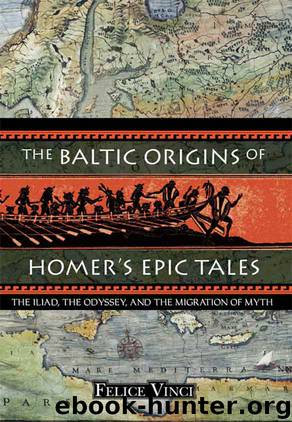The Baltic Origins of Homer's Epic Tales by Felice Vinci

Author:Felice Vinci
Language: eng
Format: epub
Tags: History/Classical Studies
ISBN: 9781594776458
Publisher: Inner Traditions/Bear & Company
Published: 2011-10-31T16:00:00+00:00
A CULTURE ON THE MOVE
The great Greek poet Hesiod sets “those who died at Thebes and Troy” in an intermediate period between the Bronze and Iron Ages,40 as if he were aware of the gap between the two epochs or, rather, the break marked by migration from the Baltic to the Aegean world after the Trojan War.
This significant move can be dated to around the beginning of the sixteenth century B.C.E. As the French scholar Pierre Lévêque reports, “towards 1600–1580 B.C. there was a dramatic change in Greek civilization. Archaeologists define it as the passage from the middle Helladic to the recent Helladic.”41 The latter period, which lasted until about 1100 B.C.E., is also known as the Mycenaean period, from the name of the most important site in Argolis. It coincides with the Achaeans’ (Mycenaeans’) arrival in Greek territory and the concurrent appearance of “northern” tendencies, such as a preference for amber, which came only from the Baltic area, and helmets decorated with boar tusks, such as the one Ulysses wears (Iliad 10.261–65) during his night raid with Diomedes in Trojan territory. These two “fashions” appeared at the beginning of the recent Helladic period but disappeared soon after.
The prevalence of amber in Greece with the arrival of the Achaeans and its subsequent rapid disappearance is actually quite significant. Colin Renfrew claims that “amber from the Baltic first makes its appearance in the Aegean around the time of the shaft graves of Mycenae.”42 On this subject, Martin Nilsson writes:
[A]mber is found frequently and in great quantities in many Mycenaean tombs of the mainland, e.g., in the earliest shaft graves at Mycenae, in the bee-hive tombs at Kakovatos-Pylos, which belong to a transitional stage between the Early and Middle Mycenaean periods, and in many other tombs; it is found in almost every new excavation of Mycenaean cemeteries. The curious fact is that it is especially found in earlier Mycenaean tombs, while it is scarce or altogether absent in later tombs. The extreme scarceness of amber in Crete is in striking contrast to the abundant finds on the mainland . . . There is only one explanation of the difference, viz., that a people immigrating from the north brought the taste for and the use of amber with it . . . 43
Also: “[A]nalysis has shown that this amber is of northern, probably Baltic origin, and the amber must certainly have come overland from the north.”44
As to the boar tusks on Ulysses’ helmet, Scandinavians and Germans often reproduced boars on their helmets as symbols of a warrior’s force. Moreover, Tacitus informs us that the Nordic warriors “wear amulets in the shape of a boar [formas aprorum gestant] as a protection from all dangers.”45
Mycenaean archaeology provides us with a good deal of further evidence of the migration of Mycenaeans from north to south. Nilsson writes:
A very important discovery was made in a chamber tomb at Dendra. It seems to have been a cenotaph. In the tomb there was a hearth, and a sacrificial table,
Download
This site does not store any files on its server. We only index and link to content provided by other sites. Please contact the content providers to delete copyright contents if any and email us, we'll remove relevant links or contents immediately.
| Ancient & Classical | Arthurian Romance |
| Beat Generation | Feminist |
| Gothic & Romantic | LGBT |
| Medieval | Modern |
| Modernism | Postmodernism |
| Renaissance | Shakespeare |
| Surrealism | Victorian |
4 3 2 1: A Novel by Paul Auster(12289)
The handmaid's tale by Margaret Atwood(7681)
Giovanni's Room by James Baldwin(7198)
Asking the Right Questions: A Guide to Critical Thinking by M. Neil Browne & Stuart M. Keeley(5650)
Big Magic: Creative Living Beyond Fear by Elizabeth Gilbert(5616)
Ego Is the Enemy by Ryan Holiday(5297)
The Body: A Guide for Occupants by Bill Bryson(4976)
On Writing A Memoir of the Craft by Stephen King(4864)
Ken Follett - World without end by Ken Follett(4647)
Adulting by Kelly Williams Brown(4489)
Bluets by Maggie Nelson(4477)
Eat That Frog! by Brian Tracy(4438)
Guilty Pleasures by Laurell K Hamilton(4362)
The Poetry of Pablo Neruda by Pablo Neruda(4041)
Alive: The Story of the Andes Survivors by Piers Paul Read(3970)
White Noise - A Novel by Don DeLillo(3955)
Fingerprints of the Gods by Graham Hancock(3943)
The Book of Joy by Dalai Lama(3904)
The Bookshop by Penelope Fitzgerald(3780)
